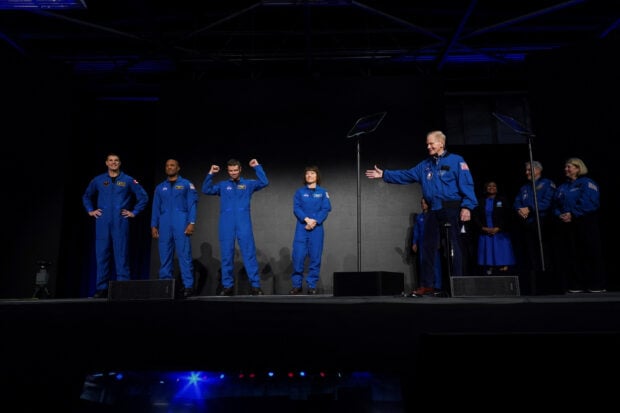NASA names woman, Black astronauts to Artemis II crew in lunar first

The administrator of NASA Bill Nelson and astronauts Reid Wiseman, Victor Glover, Jeremy Hanson and Christina Koch, crew members of the Artemis II space mission to the moon and back, attend an NASA event in Houston, Texas, US, April 3, 2023. REUTERS/Go Nakamura
NASA on Monday, April 3, 2023, named the first woman and the first African American ever assigned as astronauts to a lunar mission, introducing them as part of the four-member team chosen to fly on what would be the first crewed voyage around the moon in more than 50 years.
Christina Koch, 44, an engineer who already holds the record for longest continuous spaceflight by a woman and was part of NASA’s first three all-female spacewalks, was named as a mission specialist for the Artemis II lunar flyby expected as early as next year.
She will be joined by Victor Glover, 46, a US Navy aviator and veteran of four spacewalks who NASA has designated as pilot of Artemis II. He will be the first Black astronaut ever to be sent on a lunar mission.
Rounding out the crew are Jeremy Hansen, a Royal Canadian Air Force colonel and first Canadian ever chosen for a flight to the moon, as a mission specialist, and Reid Wiseman, another former US Navy fighter pilot, named as mission commander. Both are 47.
All three NASA astronauts chosen for the Artemis II mission are veterans of previous expeditions aboard the International Space Station. Hansen, an astronaut from the Canadian Space Agency, is a spaceflight rookie.
The Artemis II quartet were introduced at a pep rally-like event attended by journalists, local elementary school students and space industry leaders, televised from Houston at the Johnson Space Center, NASA’s mission control base.
“The Artemis II crew represents thousands of people working tirelessly to bring us to the stars. This is humanity’s crew,” NASA Administrator Bill Nelson said on stage. “We are going.”
US President Joe Biden privately called the four on Sunday to congratulate them, the White House said.
Artemis II will mark the debut crewed flight – but not the first lunar landing – of an Apollo successor program aimed at returning astronauts to the moon‘s surface later this decade and ultimately establishing a sustainable outpost there as a stepping stone to future human exploration of Mars.
The kickoff Artemis I mission was successfully completed in December 2022, capping the inaugural launch of NASA’s powerful next-generation mega-rocket and its newly built Orion spacecraft on an uncrewed test flight that lasted 25 days.
The objective of the 10-day Artemis II journey around the moon and back, is to demonstrate that all of Orion’s life-support apparatus and other systems will operate as designed with astronauts aboard in deep space.
Artemis II will venture some 6,400 miles (10,300 km) beyond the far side of the moon before returning, marking the closest pass humans have made to Earth’s natural satellite since Apollo 17, which carried Gene Cernan and Harrison Schmitt to the lunar surface in December 1972.
They were the last of 12 NASA astronauts – all of them white men – who walked on the moon during six Apollo missions starting in 1969 with Neil Armstrong and Edwin “Buzz” Aldrin.
Lunar flight plan
At its farthest distance from Earth, Artemis II is expected to reach a point more than 230,000 miles (370,000 km) away. The typical low-Earth orbit altitude of the International Space Station is about 250 miles above the planet.
Carried to Earth orbit atop NASA’s two-stage Space Launch System (SLS) rocket, the Artemis II crew will practice manual maneuvers with the Orion spacecraft before handing back to ground control for further tests and the lunar flyby portion of the mission.
After looping around the moon, Orion will use gravity of the Earth and moon to send it on a propulsion-free return flight lasting about four more days, ending in a splashdown at sea.
If Artemis II succeeds, NASA plans to follow a few years later with an unprecedented landing on themoon‘s south pole with astronauts, one of them a woman, on Artemis III. Further crewed missions would follow about once a year.
Compared with the Apollo, born of the Cold War-era US-Soviet space race, Artemis is a broader based program, enlisting commercial partners such as Elon Musk’s SpaceX and the space agencies of Canada, Europe and Japan.
It marks a major redirection of NASA’s human spaceflight ambitions beyond low-Earth orbit after decades focused on flights to and from the space station.
RELATED STORIES:
Nasa unveils new spacesuit specially tailored for lunar wear
Nasa rover preparing to take first Mars rock samples
Disclaimer: The comments uploaded on this site do not necessarily represent or reflect the views of management and owner of Cebudailynews. We reserve the right to exclude comments that we deem to be inconsistent with our editorial standards.
